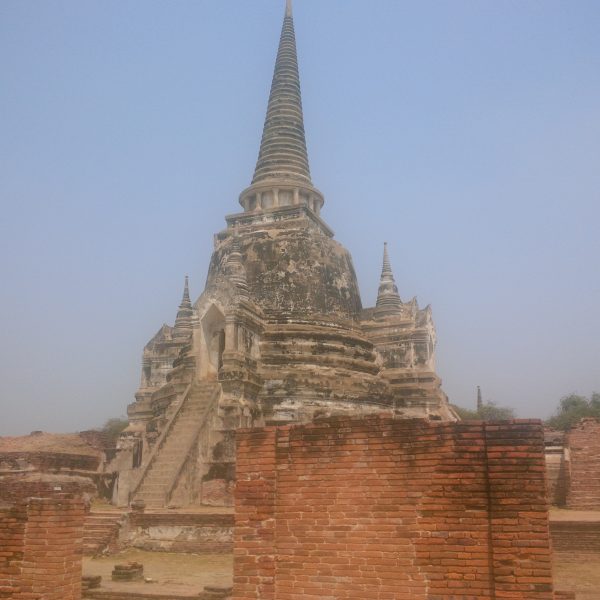Raymond Lam
Ayutthaya is a city situated at the heart of Thailand’s maritime and overland history. Its main attraction, Ayutthaya Historical Park, boasts a period of spiritual piety and medieval might dating back to 1351. It has seen Hindu-Buddhist interaction, Chinese and Japanese trade, economic and political cooperation with the Portuguese, French, English, and Dutch East India Companies, and wars with neighboring kingdoms—one of which led to the kingdom’s destruction at the hands of Burma in 1767.
Like so many littoral cities whose prosperity and influence depended on the coastline or river (for Ayutthaya, it was the Chao Phraya River), trade and multiculturalism were the hallmarks of the kingdom, much like Venice, Boston, and other cities built on the commerce of the waves. I visited some sites at the Historical Park on 4 March. The ruins are a majestic, evocative blend of multicultural influences, from Chinese and classical Indian to Khmer influences. The history behind these ruins tells the story of a kingdom shaped and defended by powerful Buddhist monarchs.
Wat Phanan Choeng houses the oldest Buddha image in the country, referred to as Luong Po To. The distinctly Chinese name of this image alludes to the (reputedly) Song Dynasty refugees who migrated here in 1324. It was even visited by the Ming maritime commander Zheng He in 1407. This massive, 19-meter Buddha statue has been revered for centuries as a protector of mariners, which is not a far stretch from the even older idea of the Buddha being a guardian of iterant travelers and merchants making long and often perilous journeys across India and the Silk Road across Asia.
The most important temple complex in old Ayutthaya was Wat Phra Si Sanphet, which was built in 1350 by King Ramathibodi I, or U-thong (1314–69). It served as the personal, private temple to Ayutthaya’s royal family, with coronations being conducted and deceased kings’ ashes buried there. The three chedis (stupas) built in Ceylonese style are the most commonly highlighted features of the complex, mainly because they’re believed to hold the ashes of three kings.
My favorite site was easily the Khmer complex of Wat Mahathat, which boasts a complex of temple ruins that have left behind tantalizingly visible floor layouts and half-wrecked Buddha images. Different dates put its construction at roughly the founding of Ayutthaya in the 14th century. It was once the residence of the supreme patriarch and the symbolic repository of the Buddha’s relics. Like other Khmer structures, the highlight is the prang at the center of the complex, a large and sophisticated structure built for Hindu and Buddhist temples in the Khmer Empire. In Thailand, the prang was reserved for very important Buddhist temples, and Wat Mahathat’s majestic, sprawling prang is a statement of its obvious influence and power.

 Personally, I was most struck by the half-intact structures. There were several “satellite viharas” surrounding the prang and a long gallery of headless Buddha statues, or Rabieng Khot. At each of these places, all one needed to do was use a bit of imagination and imagine the Buddha images intact, the pillars at their full height, and the ceiling and roof restored. Then one could imagine the repainted statues and colored walls and floor, the sounds of the chanting monks and their footsteps—and the heady smell of the incense and the monastic processions that surely took place on the ground I and many other visitors stood on. It was a humbling experience, and one that could be recreated at any historical site in the world, given enough background knowledge.
Personally, I was most struck by the half-intact structures. There were several “satellite viharas” surrounding the prang and a long gallery of headless Buddha statues, or Rabieng Khot. At each of these places, all one needed to do was use a bit of imagination and imagine the Buddha images intact, the pillars at their full height, and the ceiling and roof restored. Then one could imagine the repainted statues and colored walls and floor, the sounds of the chanting monks and their footsteps—and the heady smell of the incense and the monastic processions that surely took place on the ground I and many other visitors stood on. It was a humbling experience, and one that could be recreated at any historical site in the world, given enough background knowledge.
This is the joy of learning history. It’s not just about learning of our past achievements and mistakes. It’s about telling a story as gripping and immersive as any the best novelist could write.

